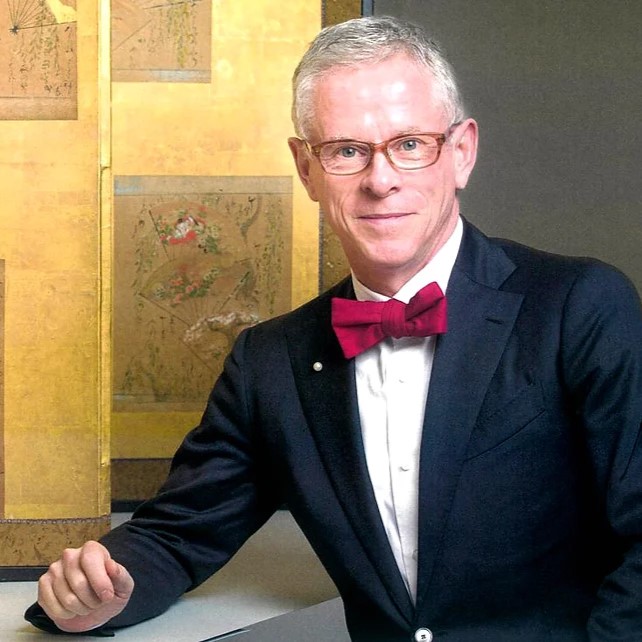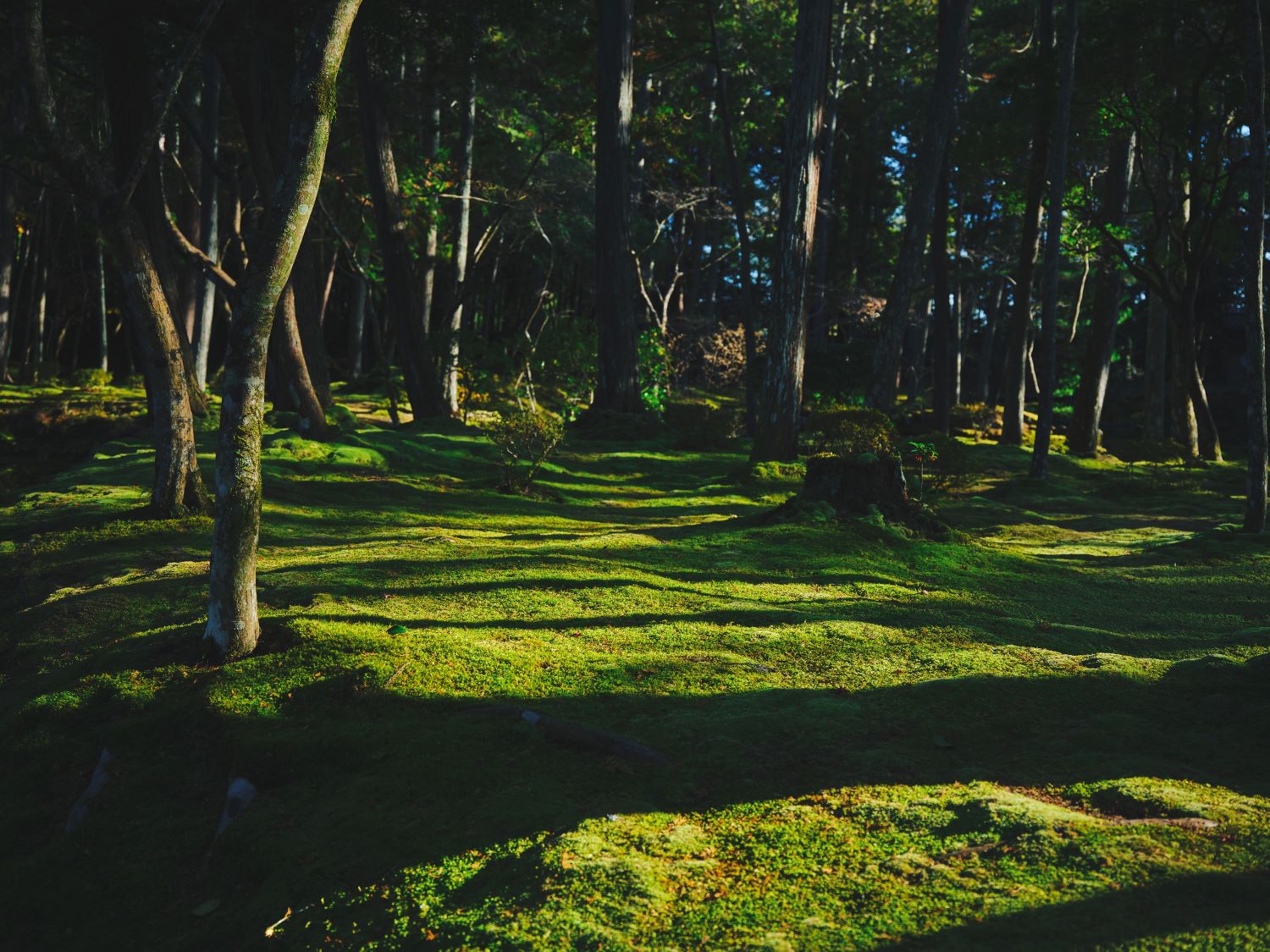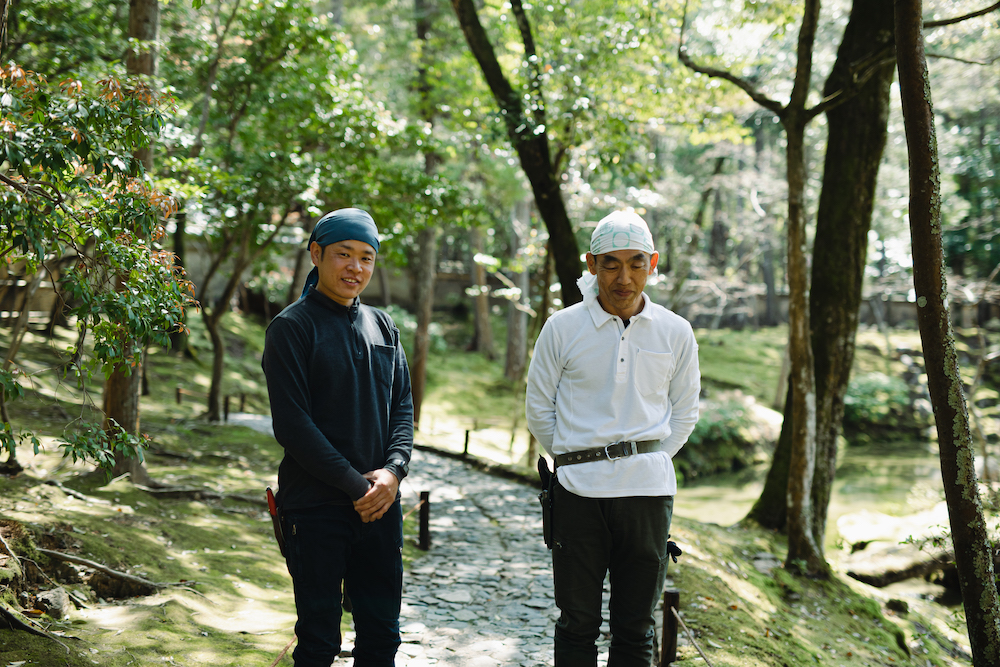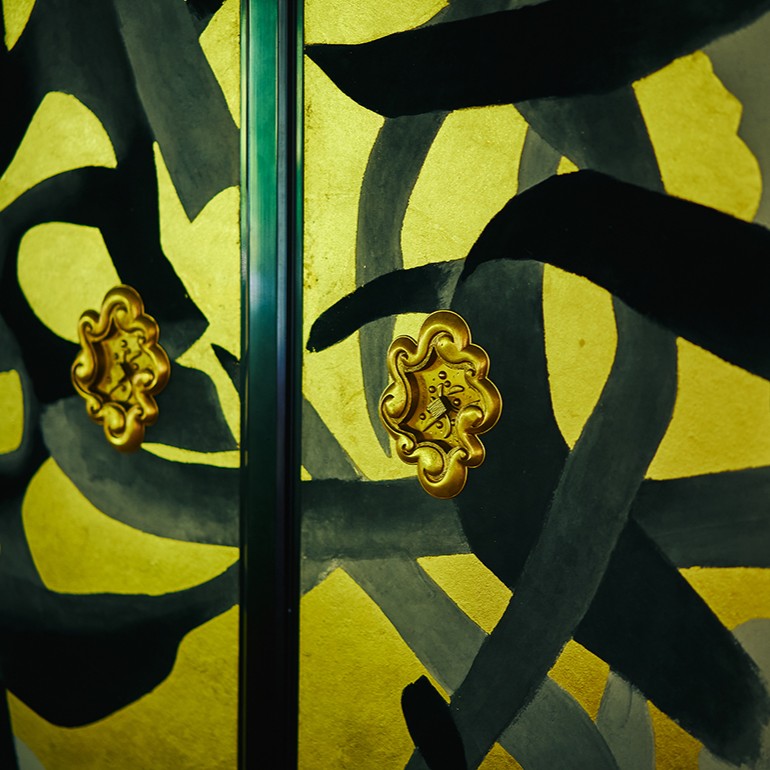2024.7.20
体露金風 西芳寺 第三景
ピーター・J・マクミラン
(翻訳家・詩人)
翻訳者であり詩人でもあるピーター・マクミラン氏が、西芳寺の魅力を綴る「体露金風 西芳寺」シリーズ。日本文化への造詣が深いピーター氏の感性と深い洞察が誘う、心の旅。ぜひ原文の美しい響きも、ご堪能ください。
作庭家からみる苔庭
西芳寺百景に欠かせないのは、私の友人や、さまざまな経歴を持つ方々といったゲストの声です。私がまずお連れしたのは、有名な作庭家、植治次期十二代の小川勝章さん。小川家は代々、京都の名だたる庭園を手がけてきました。
初めて小川さんと話しをしたときに彼が教えてくれたことがあります。それは、桜の木は、時期がくれば一斉に綺麗な花を咲かせますが、普段はその気配をものの見事に隠しきっているということ。小川さんは、桜やほかの植物の在り方から、生き方を学ぼうとしているのだと言います。その考え方があまりに印象的で、私は小川さんが先生のように思えてきました。
私の親しい友人のひとりに、九星気学という占いの鑑定士がいるのですが、小川さんは私よりいくぶん若いにも関わらず、まるで先生のように思えることを彼女に伝えました。生年月日からみると、彼の星は「九紫火星」でした。この星の人は、絶えず燃える火のような人で、創作に長けているのが特徴です。一見控えめに見えるのですが、実は美的感覚が優れていることでも知られています。
私の星は土星なのですが、燃える火が灰となり、大地となってゆくので、小川さんは私にとって親星となる関係です。この親星という概念はとても興味深く、小川さんがまさにそうであるように、年齢がどれだけ若くとも、親のようにものごとを教えてくれたり、成長させてくれる人を指します。

西芳寺に2人で訪れたとき、1人でお庭を見ていただくことを小川さんに提案し、それぞれ別方向からお庭を見てまわったのち、彼の感想を伺いました。小川さんはかつて、お母さまと西芳寺を訪れる予定をしていたのですが、お母さまが入院され、ついにその参拝は叶いませんでした。それ以降、この場所には、なかなか足を運ぶ気になれなかったと言います。
お庭を見てまわっているあいだ、小川さんは、作庭家という職人の視点でお庭に目を向ける自分と、心をまっさらにしてお庭と向き合いたい自分とを行ったりきたりされていました。私自身も、このお庭を訪れるたび、それと似た葛藤を感じます。気持ちをあらため、オープンな心で眺めるようにお庭に誘われるものの、どうしても雑念に邪魔をされ、気が散ってしまうときがあるのです。
作庭家としてこのお庭を見る際、小川さんが特に注目したのは、岩や石。そして、それらがどのように置かれ眺望がつくられているか、決まった視点からお庭を見てもらうためにどのような工夫がされているか、などです。その視点で見てゆくうちに、小川さんのなかで、もともとのお庭の入口は私たちがくぐったものとは違うものかもしれない、などの可能性が浮かんできました。
石は作庭時から配されており、時を経ても、その姿が変わることはほとんどないそうです。一方で、苔やほかの草花や木々は絶えず変化し続けるもの。だからこそ、小川さんはお庭を見るとき、まず石の配置に着目されるのです。また、池に浮かぶ島の1つに小さな祠がありますが、園路から見てちょうど正面にくるその配置も鑑賞の場をつくり出しているのでは、と注目しておられました。
作庭家の目線というのは、こんなにも違うのですね。普段私は、光や陰、そして苔の色合いに目を向け、鳥たちのさえずりに耳を澄ましているので、他の人の目を通してお庭を見るのは、なんとも刺激的でした。小川さんは、本当にすばらしい美的感性をお持ちの方です。きっと彼のお母さまも、彼がお庭を訪れたことや、自分のことを覚えていてくれたことを喜んでおられるはずです。立派な作庭家となられた彼を見て、とても嬉しく思っておられることでしょう。
A Garden Designer’s View of the Moss Garden
In the 100 views of Saihoji one important view is that of my guests, sometimes friends, sometimes persons of varied backgrounds. My first guest is Ogawa Katsuaki the 12th generation of the famous Ueji family of gardeners. His ancestors have created many of the famous gardens in Kyoto.
In one of our first conversations, he told me that the cherry blossom tree is excellent at hiding herself all year and then suddenly blossoming forth in all her glory. Mr. Ogawa said he would like to learn how to live from the cherry blossom and other plants. Such an impressive comment made me feel immediately that he was like a teacher.
One of my best friends is a teacher of the Kigaku, Japanese fortune telling system, and I told her that even though Mr. Ogawa is much younger than me I often feel as if he is my teacher. My friend checked his background which is based on his birthdate and discovered he is the Kyushi Kasei. It is a fire sign and people of this sign are like fires that continually burn and are great creators. They often appear to be modest but actually are known for their great aesthetic sense.
My sign is an earthen one, so Mr. Ogawa would have the relationship of what is called “oya boshi” or parent star to mine as the burning of fires creates ash which becomes earth. The oya boshi is an interesting concept because it means that even though the other person might be much younger, as is the case with Mr. Ogawa, he acts as a parent in the relationship with me, teaching and raising me up.
When we arrived at the garden, I suggested to Mr. Ogawa that he walk around alone, so we walked around the garden in opposite directions. And afterwards Mr. Ogawa gave his impressions. He said that he had once planned to come with his mother many years ago but that his mother was hospitalized so he could not visit with her, so it was a little difficult for him to come after that.
When he walked around the garden, he was split between looking at the garden from the point of view of his profession as a garden designer and just trying to absorb the garden with a completely fresh heart. I always feel a similar conflict when I come to the garden as the garden invites me to look at her with a fresh and open heart, but restless thoughts of other things often come in and disturb me.
When Mr. Ogawa viewed the garden as a garden designer the main thing that he looked at was the rocks and stones and how they were laid out to create views, to lead people to see the garden from certain perspectives etc. So as he walked around, he wondered about such things as if an entrance to the garden that was different to the one we had entered through was the original entrance.
He pointed out that the stones are part of the original design and often remain unchanged over the centuries, but the moss and other plants and trees are always changing so to see the garden, he first looks at the layout of the stones. He also pointed out that the placing of the small shrine on one of the islands in the pond creates a place of viewing because we approach it from the front.
I realized that the view of a garden designer is totally different. I always first look at the light, shadows, the greenness of the moss, and listen to birdsong, so it was very illuminating to see the garden through other eyes. I realized Mr. Ogawa is a great teacher of beauty. And I am sure his mother was so happy that he visited the garden and remembered her. She must be so proud that her son became a great gardener.
Peter MacMillan ピーター・J・マクミラン
翻訳家・詩人。株式会社 月の舟(制作・翻訳会社) 代表取締役。
2008年に英訳『百人一首』を出版し、日米で翻訳賞を受賞。2016年9月には英訳『The Tales of Ise』(伊勢物語)、2017年には英訳『One Hundred Poets One Poem Each(新訳)』の2冊がPenguin Booksより出版される。近著に『日本の古典を英語で読む』『英語で味わう万葉集』など著書多数。2019年より朝日新聞にて「星の林に」、2022年より京都新聞にて「不思議の国の和歌ワンダーランド 英語で読む百人一首」を連載。

翻訳:福田安奈






